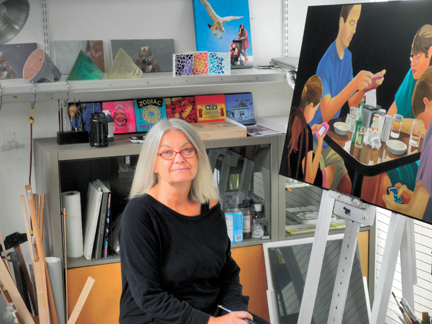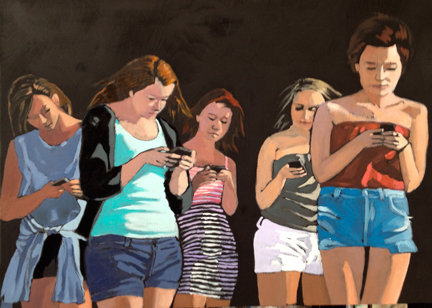
Columbus, Ohio USA
Return to Homepage www.shortnorth.com
Looking Down on Life
Eva Andry's 'Cell Phone Zombies'
By Kaizaad Kotwal
July/August 2015 Issue
Return to Homepage Return to Features Index
Eva Andry in her Los Angeles studio. © courtesy photo Technology and humans have been at odds with each other as often as they have been compatible. The same technology can both magnificently enhance human existence while threatening to help civilization self-destruct.
When humans first started to develop tools, using rocks to carve out arrowheads, hunting for sustenance became so much easier and more efficient. But the same weapons that could kill animals for food could also be used against humans for purposes of settling scores or maintaining dominion over natural resources. Centuries later, the invention of gunpowder would fundamentally transform both hunting and war in ways unimaginable by the first humans using flint and sticks as weapons.
Nuclear technology has proven to be even more fraught with contradictions. While capable of wiping out the planet (given how much nuclear weaponry the world currently sustains), even the beneficial uses of nuclear processes in creating power for an increasing global population hooked into the grid have proven to be complicated at best, destructive at worst. Japan’s Fukushima nuclear disaster in 2011 is a great case in point.
The technologies proliferated via what we now call the digital revolution have already and will continue to transform human existence, perhaps even our evolution, in ways no one could have imagined just a few decades ago. To say that cell phones and other hand-held devices have become ubiquitous is to understate their prevalence and role in our lives. While it is easy to fall into the trap of worshipping these technologies as the salvation of our species, it is equally simplistic to take the Luddite position where these technologies will be our doom and ruin. The realities lie somewhere in between.
Thus, while we may think that the Arab Spring started with a Tweet, those new technologies were not sufficient in themselves to sustain the uprising nor create a new model for future governance, laying bare the lie that social media is inherently democratizing. It is also true that many of these digital technologies are allowing us to live in ways not possible in the recent past, especially in the arena of medicine and human health.
Our relationship with technology has been explored widely in the arts: from literature (Kafka, Orwell) to theatre (Elmer Rice, Anne Bogart), and from painting (Munch, Giger) to sculpture (Jeff Koons). Cinema, probably the most technological of the arts, has also reflected deeply on these issues from Chaplin’s Modern Times to all the sci-fi classics like Terminator, The Lawnmower Man, and Blade Runner. The critique of digital, virtual reality and social media technologies was iconically captured in The Truman Show and can be found in innumerable TV shows and books.
An art exhibit opening at Marcia Evans Gallery on July 2 and at the Gateway Film Center Gallery on August 10 features the work of Austrian-born artist Eva Andry who lives in Los Angeles. Her Polish parents found themselves displaced after World War II and emigrated to the U.S.
According to Andry, she has been making art for as long as she can remember, be it drawing, painting, sculpture, film and television art direction, or theme park design. “I have found great joy and a meditative healing,” she said, “that comes with creating something where there previously was nothing.”
Schooled at the Art Center College of Design in Los Angeles, Andry said she was fortunate enough to experience the teaching of Lorser Feitelson, Helen Lundeberg, Llyn Foulkes, Tony Berlant, and others who deeply influenced her work.
Girl Talk #1 Andry believes that art and the self-expression it allows has been a godsend for her sanity. She adds that creating art affords her a “non-confrontational” way of unloading what’s on her mind, and that is what led to her current series of paintings, “Cell Phone Zombies.”
Andry’s paintings focus sharply on how digital technologies and social media are affecting human interactions and relationships. They are a vivid collection of snapshots from this so-called modern life, replete with humor, nuance and even empathy. She captures the constantly WhatsApping Selfie-taking generation with keen observational skills and an ability to synthesize an image to its most essential emotions.
Andry has very strong feelings about these technologies and our over-dependence, perhaps even enslavement to them. She said that these paintings emerge from “the anger, frustration, and sense of alienation I’ve felt when confronted by people in public on their cell phones, oblivious to the reality around them.” Andry excoriates “the idle chatter of those focused solely on the gadget in their hands, which when coupled with earphones, also creates an inability to hear the real world around them.” She finds this way of “disassociation from the present, preferring not to engage in social interaction” hugely problematic. “And don’t get me started on the havoc created by condensing thoughts into abbreviated text messages where these ‘words without a face’ allow the sender to avoid the emotional reality of a person’s presence, thereby creating unaccountability and anonymity,” she concluded.
Her art is created from a desire to recapture these experiences, and she relies on memory and candid photos to come up with her works. She says she also researches via the Internet, noting that “Yes, there is a positive side to new media, obviously.”
There are some parallels in the pictures Andry captures, allowing for a sort of common artistic language to emerge. She crops her figures tightly as they fill the frame.
Her backgrounds are usually flat washes of color, allowing the locales in which her subjects float to have a universal feel – these places could be everywhere and anywhere in this world connected by Wi-Fi and the ubiquity of cell towers. The figures are also painted with a minimalist use of stroke and detail, allowing the characters to embody a more universal space.
In Airport Zombies #1, set against a bright orange backdrop, two men and one woman sit very close to each other (in an airport lounge perhaps or a medical waiting room) as they are immersed in their gadgetry. The man on the right of the frame has his laptop open on his lap while he speaks to someone on his cell phone. There is humor in the way Andry depicts him holding his hand over his mouth as he speaks – the others are too oblivious to remotely hear what he seems to want to remain more private. There is a nice tension created by how closely Andry physically packs them into the frame juxtaposed with their emotional and existential isolation in such a public place.
Words Without a Face That sense of isolation while being in such proximity to large numbers is a hallmark of this series, allowing Andry to play nicely with the notion that these technologies claim to bring us closer but actually manage to isolate us more and more. Nowhere better is that found than in Girl Talk #1. Here a group of very young women, all standing, are so deeply engrossed in what they are doing/watching on their mobile devices, that they seem lost, almost lifeless. This “zombification” of youth is amplified by Andry’s placement of the five girls in a black void. They seem to float hopelessly, attached to no one, anchored to nothing.
Give Us This Day...Our Daily Thread similarly shows a mother and father at a family meal with their son and daughter. All seem utterly engrossed with the device in their respective hands. This is a Norman Rockwell snapshot of our times created with the starkness of light, color and form in a Hopper’s work.
The titular piece Cell Phone Zombie #1 takes Andry’s sense of minimalism and abstraction to the edge. Here in a large black void, a mere head is seen floating above two hands frantically working the mobile device they hold. The only source of lighting is the bright screen of the phone, and the expression on the face is ghoulish and macabre. Verging on cartoon-like, Andry’s use of color and stroke is very evocative here.
One image that stands out is Words Without a Face. Gestural strokework and a palette of blues against a black background capture two women covered from head to toe in burkas. One of them holds a cell phone while the other seems eager to find out what can be seen on its screen. Here the role of isolation in Andry’s work seems reversed; the women, obviously isolated by their garments from society, seem to be brought together by the technology that they are engaged with. Given the history of the Arab Spring and its nexus to Twitter and other social media, this image captures the hope that such technology promises (but rarely delivers) to socially and culturally isolated groups.
Then again, not all uses of these technologies in non-western societies is for political advancement. Perhaps, just perhaps, like all girls who just want to have fun, these two women in burkas are getting ready to click a selfie!“Cell Phone Zombies” by Eva Andry is showing at Marcia Evans Gallery, 8 E. Lincoln St., from July 2 to August 8, 2015. Opening reception Thurs., July 2 from 5:30 to 8:30. Call 614-298-8847. The exhibit continues at the Gateway Film Center Gallery on August 10, 2015.
This show is a partnership project of the Marcia Evans Gallery and Puffin Foundation West, Ltd. © 2015 Short North Gazette, Columbus, Ohio. All rights reserved.
Return to Homepage www.shortnorth.com



